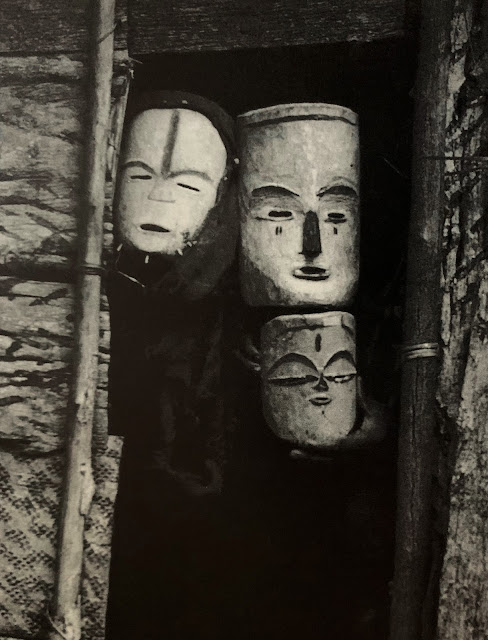Music from an Equatorial Microcosm – Fang Bwiti Music (with Mbiri Selections) – Albatros VC 0708, recorded by James W. Fernandez, 1975 reissue of Folkways FE 4214 (Cassette)
These 1959-1960 recordings by anthropologist James W. Fernandez (b.1930) highlight the fascinating ritual music performed by the Fang people of Gabon during Bwiti – a syncretic religion that incorporates Fang traditional ancestor cult with Christian elements – and Mbiri – a connected cult primarily dedicated to restoring the cosmic balance and well being of its devotees.
Much of the music on this record is played and sung under the influence of iboga, a psychotropic tree root chewed in small doses to energize people during all-night ceremonies. The sacred iboga is also ingested in large quantities during initiations to facilitate a multi-sensory journey between life and death conducted under the guidance of elders, who then interpret the initiates' spectacular visions in the invisible world.
The inspired, gentle, ethereal music here – played on eight-string ngombi harps, various bells and percussion, and male and female voices and choruses – offers intimate, heartfelt interactions with the ancestors, blending with the natural ambient sounds of the equatorial forest.
Ces enregistrements réalisés au Gabon en 1959-1960 par l'anthropologue James W. Fernandez (né en 1930) présente des musiques Fang rituelles fascinante dans le cadre du Bwiti – une religion syncrétique qui incorpore notamment le culte traditionnel des ancêtres Fang avec des éléments empruntés au Christianisme – et le Mbiri – un culte associé dédié à la restauration de l'équilibre cosmique et du bien-être des adeptes.
L’essentiel de la musique sur ce disque est jouée et chantée sous l'influence de l'iboga, un arbre aux racines psychotropes mâché à petites doses afin de stimuler les adeptes lors de longues cérémonies nocturnes. L'iboga sacré est également ingéré en grande quantité lors d’initiations en forme de voyages multi-sensoriels entre la vie et la mort sous la conduite de sages, qui interprètent ensuite les visions spectaculaires des initiés dans le monde invisible.
La musique inspirée, douce et éthérée – jouée ici sur des harpes ngombi à huit cordes, diverses cloches et percussions, ainsi que des voix et des chœurs masculins et féminins – propose des interactions sonores sensuelles avec le monde des ancêtres, qui se mêlent aux riches sons naturels de la forêt équatoriale.
*Condensed and paraphrased from James W. Fernandez’s liner notes.
Our other Gabonese music posts:
Musiques des Mitsogho et des Batéké – Ocora OCR 84, 1965-1968 here
Musique Bantou d'Afrique Équatoriale – BAM LD 324, 1946 here
Check out the essential Smithsonian Folkways catalogue with well over 100 albums of authentic African traditional music albums and much, much more here
The photographs below are from Visions d’Afrique – Fang by Louis Perrois, 5 Continents, 2006, and Masques d’Afrique by William Fagg, Fernand Nathan/L.E.P., 1980:
Fang priest with Ngil mask, Moyen-Ogooué, Gabon, c. 1900:
Fang masks behind a ritual door, shot by Jacques Millot in Ediak,
near Mimongo, Gabon, 1960:
%20crop%20%20crop1%20-18%2066.jpg)
%20-11%2027.jpg)
%20good%20color%20-9%2024.jpg)
%20-18%2038.jpg)

%20-35%20100.jpg)
Some entrancing harp work here to be sure.
ReplyDeleteMerci, thank you!
ReplyDeleteDear Music Republic. After having been away from your blog for a few years (life was getting in the way, somehow), I'm very happy to come back and still find your invaluable, beautifully curated blog being continued, amidst all the madness our world is going through. I'm very much looking forward to working my way through your posts, from September 2022 up until the present day. I'm sure my life will be all the richer for it.
ReplyDeleteUn grand merci ! Thank you so much !